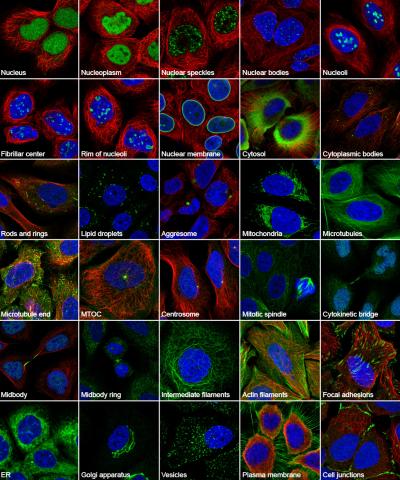![The Cell Atlas, a comprehensive image-based map of subcellular protein distribution, has been completed. In these Cell Atlas images, subcellular structures have been immunofluorescently annotated. (Proteins appear in green; microtubules, in red; and the nucleus, in blue.) Such images helped scientists classify about half the proteome’s proteins into one or several of 30 subcellular compartments. [Human Protein Atlas]](https://genengnews.com/wp-content/uploads/2018/08/May16_2017_HumanProteinAtlas_CellAtlas2131967923-1.jpg)
The Cell Atlas, a comprehensive image-based map of subcellular protein distribution, has been completed. In these Cell Atlas images, subcellular structures have been immunofluorescently annotated. (Proteins appear in green; microtubules, in red; and the nucleus, in blue.) Such images helped scientists classify about half the proteome’s proteins into one or several of 30 subcellular compartments. [Human Protein Atlas]
Spatial demography—the spatial analysis of demographic processes—has long been used to derive insights from otherwise bewildering masses of data. Back in 1854, it was used by John Snow to identify the Broad Street pump as the source of a cholera outbreak in London. More recently, it was taken up by the U.S. Census Bureau, which generates analyses indicating how government resources might be distributed across geographically defined administrative units. And now, spatial demography has come to proteomic research.
The first analysis of how proteins are arranged in a cell has been completed. It promises to refine existing protein–protein interaction networks. In addition, it provides an important resource to deconvolute the highly complex architecture of the human cell.
This analysis, an examination of the spatial distribution of the human proteome, appeared May 12 in the journal Science, in an article entitled “A Subcellular Map of the Human Proteome.” It details the in situ localization of 12,003 human proteins at a single-cell level to 30 subcellular structures, enabling the definition of 13 major organelle proteomes.
The article’s authors, led by Emma Lundberg, Ph.D., associate professor at KTH Royal Institute of Technology, considered the majority of protein-coding genes and described in unprecedented detail the distribution of proteins to the various organelles and substructures of the human body's smallest unit, the cell.
“Here, we present a comprehensive image-based map of the subcellular protein distribution, the Cell Atlas, built by integrating transcriptomics and antibody-based immunofluorescence microscopy with validation by mass spectrometry,” wrote the article’s authors. “Exploration of the proteomes reveals single-cell variations of abundance or spatial distribution, and localization of approximately half of the proteins to multiple compartments.”
The Cell Atlas is the result of more than 10 years of research within the Human Protein Atlas program, and was launched in December 2016. The article in Science describes the detailed analysis of hundreds of thousands of images created as part of this international effort, which also involved groups in China, South Korea, India, Denmark, and Germany.
The Cell Atlas team generated more than 300,000 images to systematically resolve the spatial distribution of human proteins in cultivated cell lines and map them to cellular compartments and substructures with single-cell resolution.
Within a cell, the organelles create partitions that form an enclosed environment for chemical reactions tailored to fulfill specific functions in the cell. Since these functions are tightly linked to specific sets of proteins, knowing the subcellular location of the human proteome is key knowledge for understanding the function and underlying mechanisms of the human cell.
“Only by studying the molecular components of the body's smallest functional unit—the cell—can we reach a full understanding of human biology,” says KTH professor Mathias Uhlén, Ph.D., director of the Human Protein Atlas. “The Cell Atlas provides researchers with new knowledge that facilitates functional exploration of individual proteins and their role in human biology and disease.”
The published article also includes a comparative study performed by Kathryn Lilley, Ph.D., director of the Cambridge Centre for Proteomics, at Cambridge University, UK, which enabled the antibody-based immunofluorescence (IF) microscopy analysis to be validated by an alternative mapping strategy that used mass spectrometry.
Interestingly, about one-half of the proteins are found in more than one compartment revealing a shared pool of proteins in functionally unrelated parts of the cell. This finding sheds new light on the complexity of cells.
The Cell Atlas is an open access resource that can be used by researchers around the world to study proteins or organelles of interest. Lundberg says, “The Atlas enables systems biology and cell modeling applications, and it is also a highly valuable resource for machine learning applications in image pattern recognition.”


